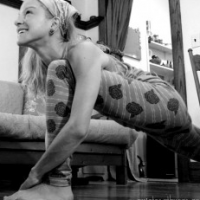Teaching yoga is a privilege, right?
I mean, we all know this; not every practitioner, no matter how ‘good’ his or her practice, should be a teacher and not every teacher is going to have a flawless practice. While that rare creature—the inspiring and truly intuitive teacher—is most often born that way, one can learn how to teach well, but only through patience, perseverance, and a damn huge, kick-ass store of courage.
Wanting to teach is understandable; all practitioners keep practicing because they were once inspired by their teacher. That teacher left such a mark, that to teach seems the ultimate expression of that gratitude. But let me stop you there. Here’s the question: Do. You. Really. Want (really, really want). To. Teach?
Yes—to inspire others is a wonderful, fulfilling goal. But it takes a hell of a lot of work and a hell of a lot of sacrifice and there are other ways to inspire (leading by example, for instance). I’d never want to discourage anyone unduly, but let’s look at the down and dirty of teaching yoga.
First and so very important: you need to have your own, independent practice. Need to. You really, really, really do. You can’t use your class as your practice. Why? Because you’re not teaching the class when you’re giving your full expression to your own body and to your own mat.
And if you try to combine those two? Your teaching and your practice? You will burn out. You will resent your students for taking time away from your practice; you’ll be tired, grumpy, and short-tempered—even when you think you’re hiding it? You’re not. (Oh-ho, did I learn this lesson the hard way but that, perhaps, is another article.)
So, have a daily practice. Have your own teacher, even if you only see him or her once a year. Be always a student. Technically, you can teach what you haven’t experienced, but you won’t teach it well (and you’ll teach it, well, technically). Until you’ve discovered how your own body moves, how it changes from day to day, you won’t be able to feel that (…figuratively…) in your students’ bodies. Discover every day; get on your mat every day (even when you really, really don’t want to). Oh, and take a day off once a week—a day off from teaching and from practicing.
Second: you are there to teach the students, not to teach your own practice. The other day I was in a class (a regular Vinyasa class, not an advanced class) and the instructor was pushing his students (not physically, but verbally) to go further into poses, poses that I could see, when I surreptitiously looked around the room, that most were clearly not ready for.
Afterwards, I heard a student say that she felt she had to try to go further, even though she didn’t feel safe. Most agreed. This instructor, though I’m sure he meant well (I hope he meant well), didn’t tune into the energy of the class. And, yes, technically that student chose to push herself, but she was (in her own perception) made to feel uncomfortable. As a teacher, you have to be able to scan the room and get a feel for your students. You also have to be ready and willing to change your plan on a moment’s notice. You have no control over who walks into the room and, even if you did, you have no control over the condition of their bodies on that particular day.
Be observant—teach to the middle level of the class, but offer modifications to the beginner and advanced practitioner (unless you’re teaching a hard-core, all-out class, but even then, be aware). This is how you keep students coming back; they want to feel comfortable and safe, challenged but not cajoled or intimidated. It’s a fine balance—one that can be learned, but is best when it becomes instinctive.
Third: don’t plan (too much). It’s good to have an overview of what you want to do in the class, but too much planning makes you too rigid. Dogma is not a good place from which to teach; be fluid, willing to adjust and (scary as it is the first few times you do it) willing to throw the whole thing out and start from scratch.
Fourth: improvise. Until you can improvise an entire hour of yoga, you won’t be the dynamic, intuitive teacher that you picture in your mind. This comes with time. Trust me, as soon as you throw out that lesson plan (unless, of course, you’re teaching a very specific class on a specific pose or set of poses) you will free yourself. You’ll free yourself to become open to the needs of the class; you’ll intuit when it’s time to move into a restorative pose or hang out in a challenging pose. The students will speak to you even when they don’t, you know, speak to you.
Fifth: cultivate patience. There will be many, many times when only one student shows up. Or no students show up. And that may go on for a long, long time. Even great (read: famous and not famous) teachers were once unknown; even great teachers lay down on their mats in an empty studio wondering where they had gone wrong, how they could get more students in, if they were doing the right thing with their lives. (Ahem…this may be personal experience talking… .)
Passion will give you the last answer, but the rest? All the marketing/social media/coupon deals in the world won’t fill your yoga classes. Only a daily practice of your own can do that. Only time can do that. Only you can do that.
Like elephant journal Yoga on Facebook.
Ed: Brianna Bemel
 Share on bsky
Share on bsky





Read 5 comments and reply